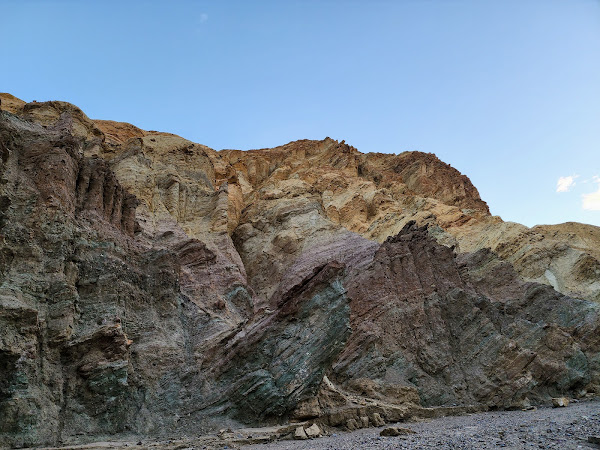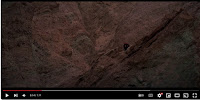[Composed 11/24/2023]
Today was our last day in Death Valley, and before we said goodbye to the Furnace Creek area, we tackled one more hike: Golden Canyon. We arrived early and were delighted to find this popular hike's parking lot empty. After taking in the amazing views from the parking lot we started the trek in earnest. Our goal was Red Cathedral, a destination we'd tried and failed to reach earlier.
When you combine the awe inspiring canyon walls with views of the neighboring badlands and mountains in the distance, its easy to appreciate why this is one of the park's most popular hikes. The hike to Red Catherdral may have been slightly uphill, but I didn't notice, I was too busy snapping pics.
Not all the sights encountered were large in scale. I was delighted to find this relatively thin, translucent rock:
Chat GPT suggests this rock is selenite, a form of gypsum. Pitt's Geology department seems to agree:
Gypsum is readily identified by its softness (a fingernail scratches it). Gypsum comes as clear crystals that display one perfect cleavage (selenite), as blocks of featureless white rock (alabaster), and as silky fibrous blocks (satin spar).
Sure enough, my fingernail scratches this rock, so I do believe I have a match. It also makes sense that this would be gypsum, as the Death Valley is know for its heavy concentration of evaporative minerals, including gypsum. Gypsum may be super common, but finding this unique (to me) speciman was like finding gold.
As we peeled off from the Golden Canyon trail to reach Red Cathedral, the hike got a bit more challenging. We had to duck under and climb up and over a few obstacles. This added to the adventure without adding a signficant amount of difficulty. You definitely want to detour to Red Cathedral.
Red Cathedral didn't disappoint. And again, we were especially appreciative to have the place to ourselves.
Hiking out of the canyon, we came across two different sites that capture the power of Death Valley in the extreme. First, consider this 'rock formation':
I figured this was an old road bed; perhaps a scar from the canyon's past industrial life. As we rounded the corner from this picture, we came upon a ranger leading a tour who was explaining the story behind this artifact. I was right about the road part, but wrong about the timing and role. The road was built by the National Park Service (NPS) in 1930. Up until 1976, it was used by tourists to drive through Golden Canyon. After hiking the canyon, it seemed crazy to drive this, yet we drove through Aritsts Pallet a few days ago, so maybe at the time a road made sense. OK, so the park had a road and phased it out for a hiking trail, what's the big deal? The big deal is that it was Mother Nature, not the Park Service that decided to remove the road. And she did it in one epic purging. Weather.gov explains:
One of Death Valley’s wettest periods ever on record took place in February 1976 when a total of 2.37 inches fell. This was reported from the observation days of the 6th through the 10th when a mid and upper level trough moved across California. The wettest 24 hour period was from the 8th through the 9th when 0.82 inch fell. The combination of days of heavy rain and persistent runoff along with rugged terrain in Death Valley resulted in a significant flash flood in Golden Canyon, located south of Furnace Creek and north of Badwater. At this time a paved road ran through Golden Canyon. However, it was no match for the surge of water, rock and mud that was forced through the narrow canyon by heavy rain on February 9th. The paved road that wandered through Golden Canyon was wiped out completely. Left behind was a crumbled mess of macadam that was no longer drivable. Today access into Golden Canyon by foot allows one to see the ruins of the paved road that once wandered through here.
Damn nature, you don't play.
Also on our way out of the canyon we came across these cool looking crystals:
The NPS's mobile app contains an audio tour of Golden Canyon. Stop #4 is these crystals:
While I pegged this site as a beautiful formation, it did not occur to me that like the flash flooding described above, it could be a force for actively shaping the canyon's landscape. The audio app set me straight. Here's what it had to say about these crystals:
On the wall in front of you, there are white mineral crystals filling the cracks and crevices of the rock. These delicate crystals grew as mineral rich water passed through the rock, the water evaporated, but the minerals remained. Please treat the crystals with care so other hikers can enjoy them too. While these crystals may be small, they have a big impact on Golden Canyon.
As more minerals fill the cracks and crevices the crystals slowly build up and forced the cracks to grow larger. Eventually, this causes slabs of rock to break from the canyon walls and create rock falls. Some rock falls are large and obvious, while others are hardly noticeable. Over time, these rock falls dramatically changed the canyon and it all began with a crystal smaller than your pinky nail.
Considering that these crystals only grow when there is rain, and rain is so very infrequent in Death Valley, it follows that these crystal must grow glatial speed. And yet, Mother Nature doesn't care; she is infinitely patient.
And finally, I would be remiss if I didn't point out the connection between Star Wars and Golden Canyon. Golden Canyon was used to shoot the scene in the New Hope where the Jawas capture R2D2. Check out the scene here. That landscape is 100% Golden Canyon.
So if the Star Wars special effects team created the mythical Bantha creature by putting an elephant in a furry costume, how do you imagine they created the Jawas? For the Death Valley scenes, the team grabbed kids with the right height from Death Valley Elementary School and put them in robes. Problem solved:
Remember the Jawas, those little scavengers in the brown hooded robes who make off with R2-D2 near the beginning of the original “Star Wars” movie? Some of them are played by students recruited from a one-room schoolhouse in Death Valley in early 1977. ... “I think we mostly liked getting a day off from school,” recalls Joe Weber, who was 6 years old when he was picked to play a Jawa.
Clever Lucas, very clever!



























































